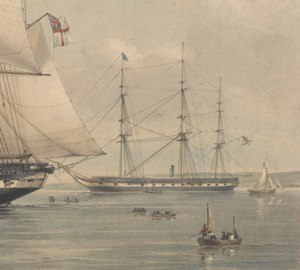This article needs additional citations for verification. (June 2019) |
HMS Amphion was a 36-gun wooden hulled screw frigate of the Royal Navy. She was initially ordered as a sail powered ship, but later reordered as a prototype screw frigate conversion.
 Amphion in 1848
| |
| History | |
|---|---|
| Name | HMS Amphion |
| Ordered |
|
| Builder |
|
| Laid down | 15 April 1840 |
| Launched | 14 January 1846 |
| Commissioned | 13 May 1847 |
| Renamed | Ordered as HMS Ambuscade, renamed HMS Amphion on 31 March 1831 |
| Fate | Sold for breaking up on 12 October 1863 |
| General characteristics as built | |
| Class and type | 36-gun frigate |
| Tons burthen | 1474 bm |
| Length | 177 ft (53.9 m) (gundeck) |
| Beam | 43 ft 2 in (13.2 m) |
| Draught | 19 ft 2 in (5.8 m) |
| Propulsion |
|
| Sail plan | Full-rigged ship |
| Speed | 6.75 knots (12.5 km/h) |
| Complement | 320 |
| Armament |
|
Design and construction
editAmphion was initially planned and ordered from Woolwich Dockyard as HMS Ambuscade on 13 May 1828, but was renamed on 31 March 1831. She was laid down on 15 April 1840, but on 18 June 1844 she was reordered as a screw propelled frigate, to a design by White. She was duly launched on 14 January 1846, and commissioned on 13 May 1847. Her engines and machinery were provided by Miller, Ravenhill & Co, to a design by John Ericsson. Amphion had cost £36,115 for her hull, with a further £16,673 spent on buying and fitting the machinery, which was installed at the East India Docks. A further £22,794 was spent on fitting her for sea, which was carried out at Sheerness. The space taken up by the machinery was found to considerably restrict the amount available to store provisions and munitions.
Career
editShe was reduced to 30 guns in 1848, but had been restored to 36 guns in 1856.
During the Crimean War, she served in the Baltic Sea. In June 1855, she ran aground at Vipuri, Grand Duchy of Finland and was fired on by Russian artillery. One of her crew was killed and two were injured.[1] She was sold to Williams on 12 October 1863 to be broken up.
See also
editReferences
edit- ^ "The War". Sheffield and Rotherham Independent. No. 1864. Sheffield. 7 July 1855. p. 5.
- Colledge, J. J.; Warlow, Ben (2006) [1969]. Ships of the Royal Navy: The Complete Record of all Fighting Ships of the Royal Navy (Rev. ed.). London: Chatham Publishing. ISBN 978-1-86176-281-8.
- Lyon, David and Winfield, Rif, The Sail and Steam Navy List, All the Ships of the Royal Navy 1815-1889, pub Chatham, 2004, ISBN 1-86176-032-9
External links
edit- Media related to HMS Amphion (ship, 1846) at Wikimedia Commons